|
Fisher Model's 1/32
scale
F9F-8 Cougar
by
Darren Roberts
|
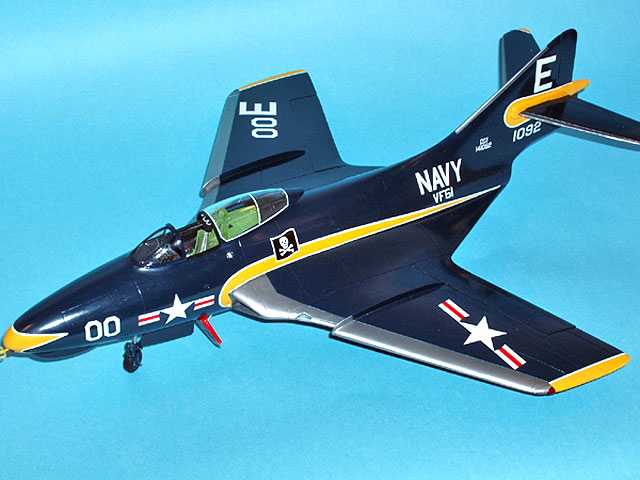 |
|
Grumman F9F-8
Cougar |

HyperScale is proudly supported by
Squadron.com
Fisher Model and Pattern has long been known for its outstanding
resin car kits. Now, Fisher has made a name for itself in the large
scale resin aircraft market. Fisher’s first release was the F9F-5
Panther, which was extremely successful. Following on its heals comes
the F9F-8 Cougar, the swept wing variant of Grumman’s F9F series.
Fisher Model's 1/32 scale F9F-8
Cougar is available online from the Fisher Model website
Background
Grumman’s F9F-8 Cougar was the last in a series of designs for the
Navy that started with the straight-winged F9F-2 Panther. After the
success of the Panther design, Grumman began working on a swept-wing
variant. The result was the F9F-6 Cougar, which was little more than a
Panther fuselage mated to a swept-wing. As the design was refined,
however, some changes were incorporated which would produce the -8
variant of the Cougar. Most notable and obvious of these changes was the
lower rudder extension on the tail. Later Cougars also featured splitter
plates in front of the intakes. The service life of the Cougar spanned
the Glossy Sea Blue scheme era, where it took on the fighter role,
through the mid 50’s change over to Gull Gray over White, where it was
given attack duties in lieu of more advanced fighter aircraft being
introduced to the fleet, such as the F11F Tiger, F4D Skyray, and
eventually the F-8 Crusader. Cougars soldiered on in Naval Reserve units
and training squadrons before finally being retired, although the Blue
Angels used a two seat TF-9 as a VIP aircraft for many years while
flying the F11F Tiger.
Fisher
Model's Cougar in the box
|
Fisher Model's 1/32 scale F9F-8 Cougar comes in a thick, sturdy
cardboard box that opens up “pizza style”. There are heavy tabs that
insert into slots, so that the box has no issues with coming open when
you want it to stay closed.
Upon opening the box, I was almost overwhelmed by the amount and
quality of the contents. Five plastic baggies contained the smaller
resin parts, while the one piece wing and one piece fuselage were
wrapped in tissue paper. The photo-etched set and decal sheets were also
protected by plastic bags.
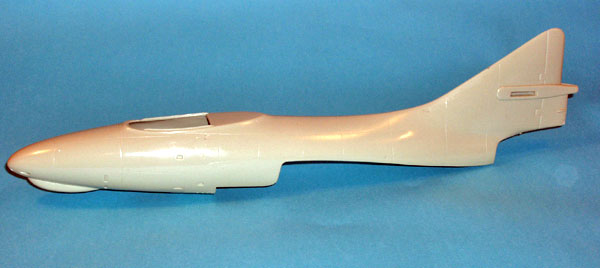
There was a 12 page instruction sheet along with a page of color
illustrations showing the various paint schemes that can be done.
The quality of the resin is hard to believe. The only surface bubbles
I encountered in the entire kit were on the underside of the wing
section behind the main gear bay and on the outer portion of the
underside of the left wing. Every other piece of resin, including the
fuselage, was bubble free. The gray resin could easily be mistaken for
plastic. The surface is smooth and recessed panel lines are
exceptionally done. There are also no casting blocks to remove from the
larger parts and very little flash can be found on the small parts.
Click on the thumbnails
below to view larger images:
Instruction Sheet
The instruction sheet is a 12 page affair that contains both print
and pictures. Page 1 is an introduction and some helpful hints on
decaling and painting. Paul Fisher also hints at more releases of Nav
Air 1/32 aircraft, including a two seat Cougar. Page 2 lists the colors
of paint needed and an overview of the photo-etched set. Pages 3-10 are
the building instructions, while page 11 contains credits and
references. Page 12 finishes off the booklet with data placement for the
stenciling. The instructions are very well laid out, with numerous
pictures to show you how everything fits together. I would have liked to
have had a page showing decal placement for the major markings, but it
is easily figured out by looking at the artwork of what scheme you’re
doing.
Photo-Etched Fret
The set contains 20 different items (there are multiples of some
pieces) that include the instrument panel, perforated speed brakes, seat
harnesses, rear decking for the cockpit, wing ribs (if you want the
flaps down), and numerous other items.
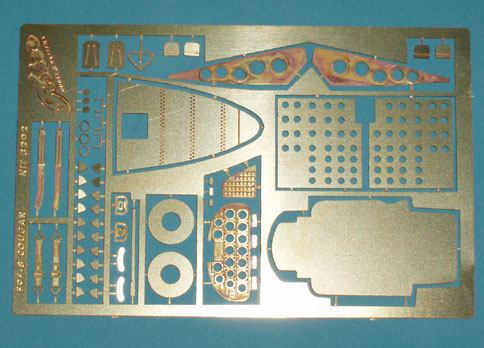
While the parts aren’t numbered
on the actual set, they are numbered on the instruction sheet, so there
is no confusion as to what is what. The parts themselves are easy to
work with. You can manipulate them without bending them beyond repair.
Decal Sheet
There were 4 decal sheets in my kit. One sheet contained the small
stenciling, while the other 3 contained the different squadron markings
and larger stenciling. Markings options are for the Blue Angels, a GSB
VF-61 Jolly Roger, a gull gray/white VF-61 Jolly Roger, and a VT-24 gull
gray/white training squadron with orange trim.
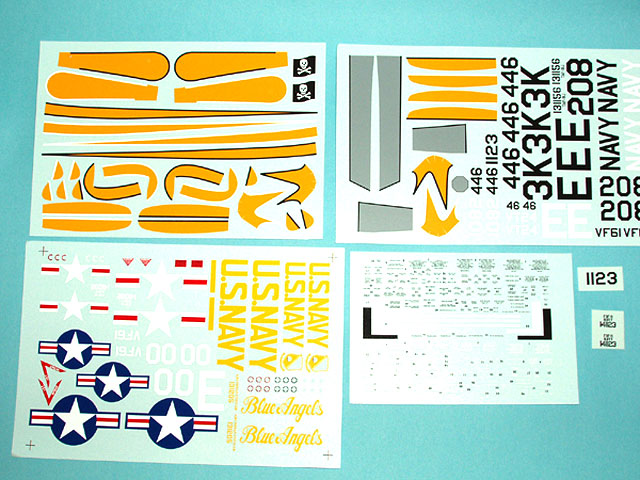
The decals are printed by Microscale and go on without any problems, including the rather
intricate VF-61 trim. The blue on the national insignias seems to be a
bit too light in color, so an aftermarket set might look better if you
plan on doing a gull gray scheme. The one major goof I found on the
sheets was that for the GSB VF-61 markings, only the left side of the
yellow nose markings is included. However, this can be overcome by
applying the piece intended for the right side of the gull gray VF-61
aircraft, which has black trim, and carefully cutting off the white trim
from the duplicated nose marking. By flipping the trim over, you can
apply it over the black trim and have it turn out just fine.
Words can hardly describe just how easily this kit went together.
Within an evening of work, the cockpit was painted and installed and
the wings were joined to the fuselage. The only filling I did on the
entire model was running some Mr. Surfacer between the wing/fuselage
joint. Even then, it almost wasn’t necessary. I started with the
cockpit, which went together with very few problems. One neat option
that Paul has done is to include a rounded space ahead of the cockpit
tub that fits 12 US pennies. This is the exact amount of weight needed
to keep the model from being a tail sitter. I had a large fishing weight
handy, so I used that instead. Another helpful addition is having the
instrument dials printed as part of the instruction sheet. After it is
cut out, you simply glue it to the back of the PE instrument panel. Pay
careful attention to dry fitting the sidewall of the cockpit and the
front gear well. While not difficult, if done wrong it will present
problems when you slide the tub into the fuselage.
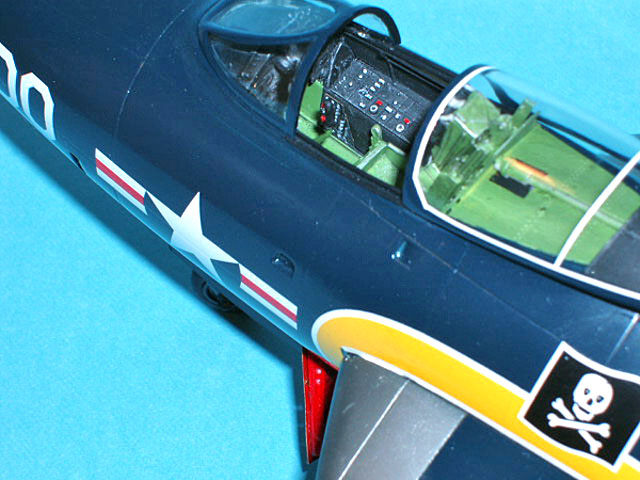
With the tub in place inside the fuselage, the wings were attached and
the minimal joint filled with Mr. Surfacer. If you choose to have the
flaps in the “up” position, there will be a gap between the inner end of
the flap and the fuselage. Any easy fix to this is to glue the flap in a
slightly “down” position if you don’t want it fully deployed. This will
alleviate the gap.
The rest of the model was finished per the instructions with no major
problems encountered. Since I was doing the VF-61 scheme, I left off the
horizontal stabs until after I had decaled it.
 I sprayed the entire model Glossy Sea Blue with Model Master Acryl
paint. I sprayed the entire model Glossy Sea Blue with Model Master Acryl
paint.
Be sure to wash the resin parts before painting, as the paint may
have a difficult time adhering to the resin because of the mold release
agent used. This is especially true of acrylics.
I used Post-It notes to mask off the leading edges so that I wouldn’t
run the risk of pulling up any of the blue. I sprayed Alclad Dark
Aluminum for the leading edges and than masked off the speed brake well
and painted it Insignia Red. With the paint cured, I applied the decals.
They reacted perfectly to Micro-Sol, and even the compound curves of the
VF-61 markings only took a couple of applications to get them to snuggle
down. There were a few little areas that needed some touch up yellow,
but nothing that was too time consuming or difficult.
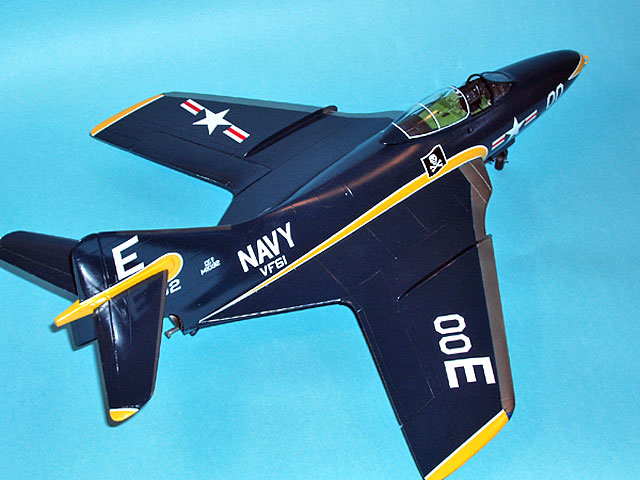
With decals down, I sprayed multiple coats of Future and polished it
with 3600 grit sanding pads to smooth it down. One final coat of thinned
Future gave it the sheen I wanted. I finished up by adding the speed
brakes and clear resin canopy.
There is also a vac canopy provided with resin framing
It is hard to believe that this is a resin kit. The fit is nothing
like I’ve ever experienced when building resin. If you have never worked
with resin, than this would be a fantastic kit to start with. It builds
like an injection molded kit, and the fit is every bit as good as
Hasegawa and Tamiya. The price is also very affordable for what you get.
The kit retails for $155.00. Other resin kits are much more than that,
and aren’t nearly as nice in regards to quality of resin and ease of
build. I don’t usually build 1/32 scale, but I’m very tempted to pick up
the next release from Fisher.
Thanks to Paul Fisher
from Fisher Model for the review sample.
Click on the thumbnails
below to view larger images:
Model, Images and Text Copyright © 2005
by Darren Roberts
Page Created 07 January, 2005
Last Updated
07 January, 2005
Back to
HyperScale Main Page
|
Home
| What's New |
Features |
Gallery |
Reviews |
Reference |
Forum |
Search